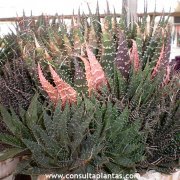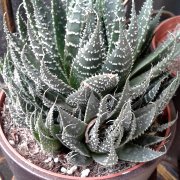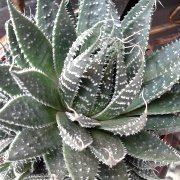Care of the succulent plant Aloe aristata or Lace aloe |
|
The genus Aloe is included in the subfamily Asphodeloideae (family Xanthorrhoeaceae), which comprises about 500 species of succulent plants native to Africa, Madagascar and the Middle East. Some species are: Aloe aristata, Aloe x caesia, Aloe pluridens, Aloe arborescens, Aloe aculeata, Aloe juvenna, Aloe variegata, Aloe striata, Aloe x delaetii, Aloe ciliaris, Aloe vera, Aloe ferox, Aloe x spinosissima, Aloe mitriformis, Aloe marlothii, Aloe maculata, Aloe plicatilis, Aloe thraskii, Aloe barberae, Aloe tenuior, Aloe suprafoliata, Aloe esculenta. Common names: Lace aloe, Guinea-fowl aloe. This species is native to South Africa and Lesotho. They are small succulent plants with a covering capacity that reach 30 cm (1 feet) in height. The leaves are dark green, are arranged in a rosette and measure up to about 15 cm (5.9") in length; they have spines, white tubers and bristles at the apex. They produce tubular, orange-colored flowers that attract bees for their nectar. They bloom in early summer. Lace aloe is used in rockeries, to cover dry areas of the garden, in greenhouses or as a houseplant in shallow pots. Aloe aristata prefers full sun or very light shade exposure if the weather is very warm. Indoors it is convenient to place them near a window. They do not resist frost and it is advisable that they have a winter rest period between 7 and 10 ºC (44-50 ºF). Dry, sandy soil is ideal for these plants as they need good drainage. Potting is done every year in early spring. Water moderately, waiting for the soil to dry. In winter, minimize watering and even eliminate it if grown near the sea. During spring and summer, Guinea-fowl aloe appreciates fertilizations every 15 days with a mineral cactus fertilizer. Over-watering causes root rot and causes the leaves to turn yellow. If it suffers from prolonged drought, the leaves wilt. Aloe aristata easily propagates from the shoots that the plant produces at the base; They are rooted in pots with well-drained, moist soil in a well-lit location without direct sunlight. |
Images of the succulent plant Aloe aristata or Lace aloe |
Find plants
Aloe aristata or Lace aloe | Care and Growing
© 2025 FavThemes






